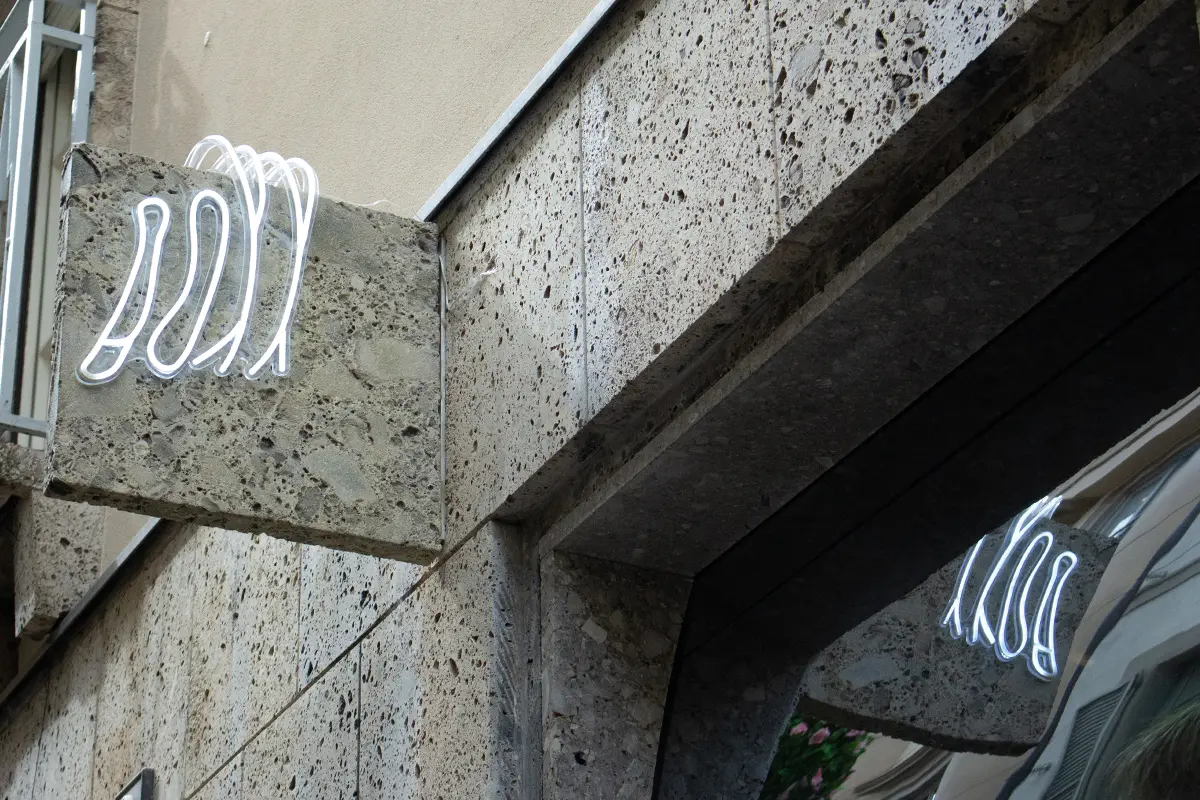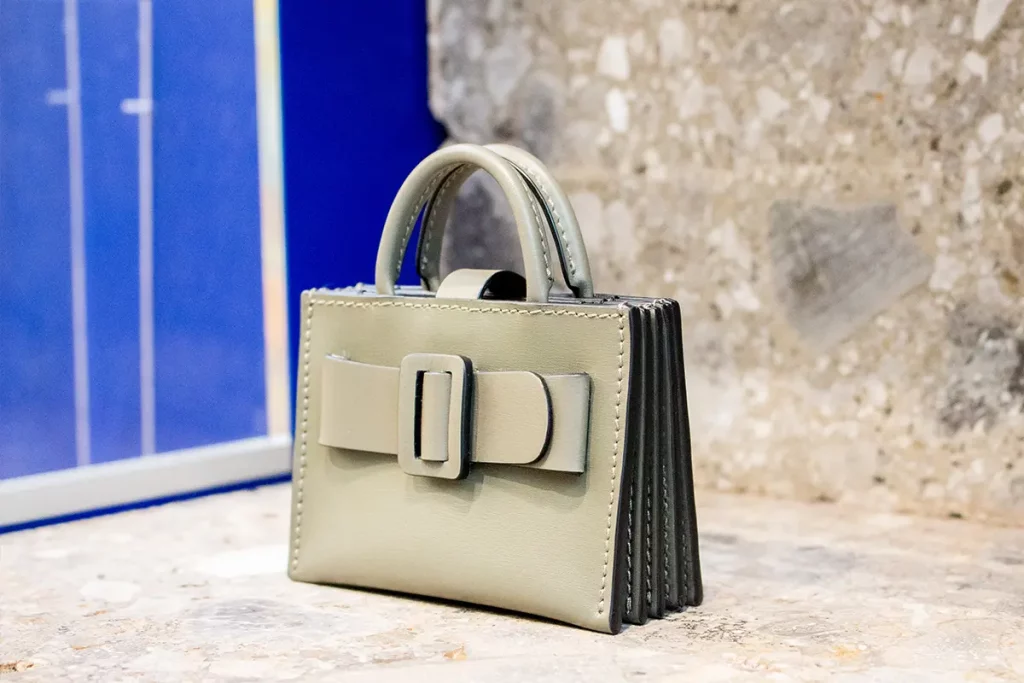Fos is all about pollination when it comes to spaces. For their Milanese store, Boyy collaborated with the Danish designer to enhance their zesty pieces
Boyy opens the first flagship in Milan
Lately, shops convey the same atmosphere of sorrowful luxury, choreographed for the eye of buyers, and less for that of an explorer. Collaborating with the Danish designer FOS, BOYY choreographs a space for hidden playfulness, where each detail is a hint towards experimentation and innovation. Ideated and run by Jesse Dorsey and Wannasiri Kongman, the accessories house found a shelter in the streets of Milan.
Jesse Dorsey and Wannasiri Kongman
The two designers chose the Italian fashion capital as their new relocation after opening over five stores. On the quiet and sunbathed street of Via Bagutta, between lush boutiques, the BOYY store comes into sight as a modern fashion destination. It used to be a furniture shop owned by an Italian lady for centuries, Jesse says, disclosing the space; its name – Old America. With that in mind, a red thread presents itself, a different Italianity conveyed by the gray marble and stones lacking the frizzly decoration of traditional facades. Venetian flooring comes as a refreshing element, and as Jesse explains, they have always been this way, hidden by a moquette rug.
Boyy and Fos – Details from a century-old furniture shop
Much of what we spot from the outer side is carefully linked to the whole identity of the store. Every bit of concrete is placed with the BOYY and FOS story in mind. The police mirror window is only as fun as the leather buckles confronting the idea of shape with a disproportionate allure.
Stopping in front of the window, you’re met with a mocking elongated reflection, where there’s no sight of the shop’s interior. The logo continues the shape refusal, written in neon lights that catch the eye. Following the ‘polarization’ technique used by FOS, a lego-esque stratified shape follows every edge with gap line insertions that help emphasize the facade layers.
Introducing unisex accessories
Created by Jesse and Wannasiri in 2006 BOYY was ideated as an opposition to classic luxury, where accessories would follow elegant aesthetics, always inspired by female celebrities and muses. With their colorful imaginary and puzzled structures, BOYY would only take the name of male artists opening the path toward a genderless accessories line. They’re bags that make you want to go out more, to mismatch them with spontaneous outfits, making the BOYY pieces all the more enjoyable.
Loyalty and involvement in the production chain
What started as a bashful experiment, when Wannasiri was working as a waitress in New York, eventually came to take the fashion world by storm, and with Jesse’s background in music, they both seemed outsiders of the industry. This made them bring innovation to the fore. They started working with showrooms in New York slowly after launching the first design, but they found it challenging to keep track of the constant requests for new collections.
Slow fashion is closer to their vibe since they still collaborate with the same ateliers and sourcing companies since inception. Taking place in Bassano del Grappo, Italy, the development process foresees custom-made materials with suede linings and calfskin leather manufacture. The duo maintained a stable relationship with the factories in Bangkok while being involved in the whole production process. «What we’re doing merits more documentation» Jesse confesses, adding «It is more of a meditation».
Boyy signature item. The buckle bag
After years of collaboration with showrooms, Jesse and Wannasiri took a step back thinking they wanted to create something timeless, therefore shifting the perspective towards brand identity. Like most emblematic pieces, the buckle belt bag was a coincidence, an accident caused by serendipity. Wannasiri saw a lady walking the street carrying a paper bag from Healthy Foods.
«I loved the boxiness of that bag», the designer recalls. Attracted by its silhouette, she asked the lady if she could take the bag home, and then and there the signature bag was born, not without challenges. The belt motif came from a 70′ vintage belt Wanasiri owned. She would wrap it around the shape of the bag playing with the idea of overstatements.
BOYY: The expression of an attitude, is not about selling products
«One of our signatures is exaggeration» Jesse would explain. But with exaggeration comes risk, and they both remember the little disputes around producing it. Jesse was convinced it wouldn’t work and it would become too impractical through the belt detail, while Wannasiri knew it would become an instant success. They went back and forth for three years until the first sample came through in 2015. It was an instant hit.
All and on BOYY is «The expression of an attitude, is not about selling products». Becoming the ideal study case of how people look to become recognizable while making part of a community, the boy-sh bags are infused with coolness and spontaneity, away from the rigid shapes or maximized embellishments of other luxury brands.
Boyy on Via Bagutta in collaboration with FOS
The same spirit is conveyed by the Milanese shop with its interiors borrowing from the exterior materiality. The walls are covered up in the original wallpaper from 1950. Scrapped at parts, colored in dingy shades of brown and beige, it maintains an elegant yet shy presence. Details like an antique cross also dating from the old shop and discarded blanks are framed on the wall, suggesting the curatorial style infused by FOS.
He exhibits the pieces, playing with accessibility and restriction on the edge of an exhibitory loop. The centerpiece – a color book green bench made of solid wood. With its stair-shaped margins, it enhances the layers accompanied by gaps in the leitmotif. Klein Blue painted walls display BOYY pieces sustained by see-through acrylic stands.
Almost every detail is handmade, with frames and glasses as the main themes of the walls. Jesse and Wannasiri agree on their favorite corner of the shop, on the left side of the entrance, close to the spy mirror. There’s a coral pink hanger occupying the whole corner and shining through the cold color-themed ambiance. Its versatility embraces the BOYY preference for playful displays, and with a malleable shape, it softens the concrete surroundings.
Boyy – The colors reminding childhood
Curious about the color palette forever present in their pieces and photographic campaigns, they confess it’s often unintentional. Rather than careful research, it comes from consuming and absorbing different contents that can come to the surface later on as inspiration. Fiorucci is one of the designers both remember growing up with and whose aesthetic remains relevant in their designs.
It is more about nostalgia and going back to childhood, remembering the color books or cartoons like Barbapapa. «Everybody loves the memory of their childhood», Wannasiri reflects. Their luxury gamification doesn’t lack sophistication, where sunny yellow and girly pinks are paralleled by nude hues and serious browns. Even when blue spots of color occupy the space, Jesse confesses it is temporary, they’re not the biggest fan of that color.
Handmade decor and Venetian-infused interiors
With a masculine edge, each piece represents the designer’s passion for developing objects which in the FOS envisioned store is an integral part of the decor. If transparency has already become an overused term in the fashion chain, for the BOYY flag store, it opens up key discussions over the stock display and merch honesty. A see-through tinted glass covers the whole wall where the shop stock is kept.
No back repository or hidden shelves, every item they have for sale is accessible to clients. It becomes a reflection of the brand’s independence and ethic chain, embodying honest storytelling. Adding attitude to the structure, the hand-made pieces embrace the use of discarded materials, like a Murano glass piece framed in wood, where FOS used rescued Murano pieces from the glass graveyard of the Venetian island. Stone, steel, acrylic, glass, and wood, all materials harmoniously come together to create a well-imbued fashion hub.
Boyy introduces the first shop publication
It might look like BOYY always keeps the gaze toward the future, even subconsciously so. They launched the Via Bagutta 9 publication, placing a synesthetic retelling of their space and designs on paper. Almost like a magazine, the publication’s kept in store but not as a catalog. Displaying random objects like toothpaste, keys, or euro bills next to BOYY accessories, the pages become all the more entertaining with colored vegetables portrayed over spacial backgrounds.
It feels like time and space traveling in a rocket with your best friends, and as much as it isn’t intended, BOYY proves how gamified luxury is worth its time. There’s even a recipe on the last page with a tip: «You can design your curry by imagining what color combination will look great together color-wise».
Ready to wear made of unisex drops – Boyy
Asking Jesse and Wanasiri what their project forecast for a ready-to-wear line is, they were hesitant, for they had nothing planned so far. Working on the Index Subcollection, they’ve already designed a reversible silk poncho, a unisex piece covered in prints of their campaigns.
It’s a billboard-made fashion, something fun to wear on any occasion. The cut is structured, but the images contrast any print norm with a trippy mix of colors and shapes – from the positive-negative juxtaposition to iridescent colors. Since their approach is instinctive yet bold, none of the upcoming outcomes can be a calculated step.
They confess to preferring to create pieces rather than collections, to create timeless imaginaries rather than hype trends. It’s what makes them the tomboy of the luxury industry, and probably the most fun to be around.




















